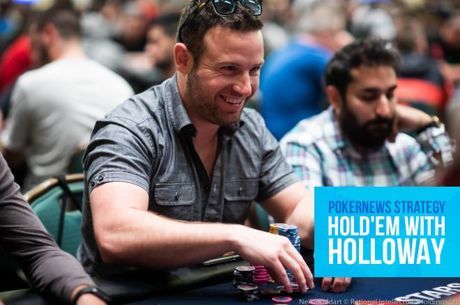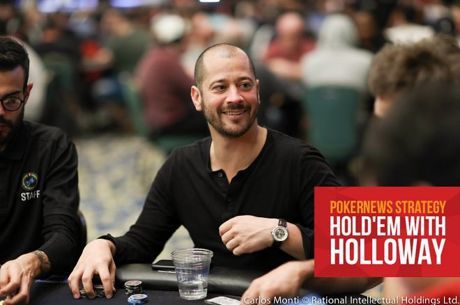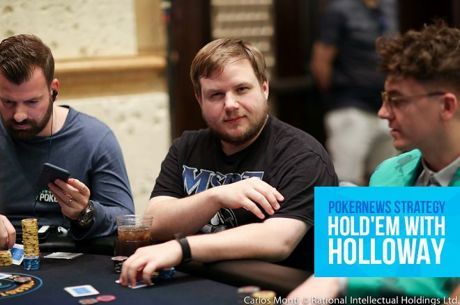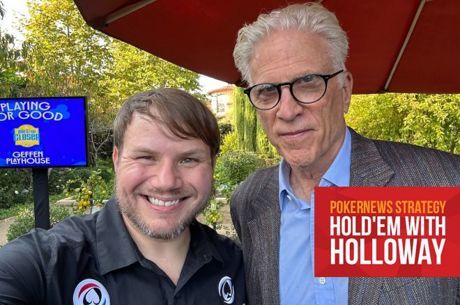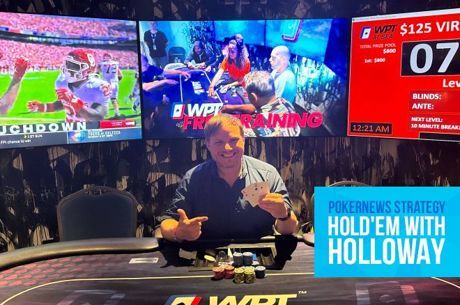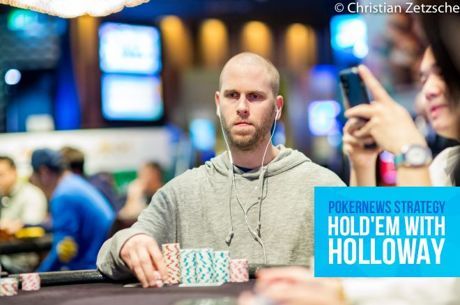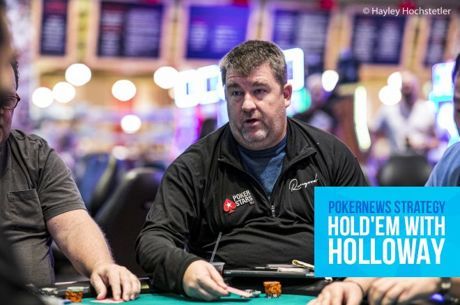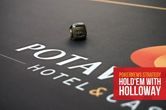Hold'em with Holloway, Vol. 98: Simon Deadman Rips Apart My NLH Tourney Play
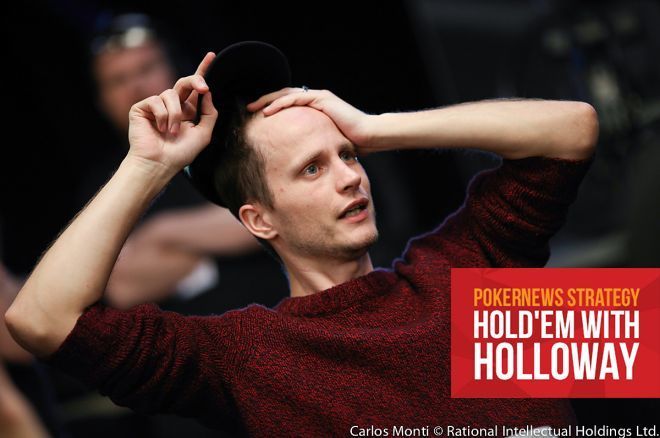
Table Of Contents
There are few tournament players I respect more than Simon Deadman. He has more than $3 million in lifetime earnings, including picking up a career-high $391,446 for finishing runner-up to Jason Mercier in the 2015 World Series of Poker Event #32: $5,000 NLH Six-Handed. He also won the 2014 Hollywood Poker Open Championship for $351,097.
Deadman �� on Twitter @SIMONDEADMAN �� offers one-on-one private coaching on simondeadmanpokercoaching.com. He also recently became a coach at Chip Leader Coaching alongside Joe McKeehen, Ryan Leng, and Daniel Strelitz, just to name a few.
I had the rare opportunity to consult with Deadman recently about a couple of hands I played in a $500 buy-in no-limit hold'em tournament, one that drew 89 runners.
Hand 1 �C Getting Lucky with Aces
In Level 3 (75/150) with 50,000 effective stacks, I picked up A?A? in the hijack and raised to 400 after the UTG+1 player had limped. The players in the cutoff and button called, as did the limper, and the flop came down 6x7x9?.
"Raise bigger preflop," Deadman says of my preflop play. "We are so deep we want to get more money in the pot, so our raise size should be at least 600 4x after a limp of 150. A bit bigger would be fine, too."
As it happened, the big blind led out for 600 and the limper called. I also just called and the cutoff popped it to 1,700. The big blind called, UTG+1 got out of the way, and I decided to call to see how things played out on turn.
"So the pot is like 1,700 and BB leads 1/3 and UTG+1 calls," Deadman recaps. "Versus this small lead size and call, I think we should raise flop for value. We are going to have the best hand a lot here on the flop, but it's vulnerable. At this buy-in level players tend to check their strong hands from the blinds, so when we raise flop here we take control of the hand and we charge all the various draws and top pairs that our opponents might have."
Deadman: "Raising flop ourselves will define people's ranges much better and make your hand much easier to play."
"If any player in this hand raises again on the flop we have a relatively easy fold," Deadman continues. "As played, when cutoff raises and BB calls I would just fold now as the cutoff's range is fairly strong. The flop is rainbow so [there are] not too many draws for him to play this way. We are likely beat by straights and sets and if we aren't already beat playing turn and river will be tough. Raising flop ourselves will define people's ranges much better and make your hand much easier to play."
The turn was the 7? and two checks saw the cutoff bet 3,500. The BB folded and I made a crying call.
"I think this is why I like folding flop as played, as again we are guessing on our opponent's range and gonna be in some tough river spots if we call again," Deadman says. "Calling at this point is probably okay given the bet size isn't huge and we can still beat some JxJx, 10x10x, and Ax9x, etc., if he ever has those."
Luckily for me, things swung in my favor when the A? spiked on the river to give me a full house. I bet 8,500 as with the flush coming in I'm hesitant to check. I figure he's prone to check behind with two pair, a straight, and so on. He tank-called and mucked what he claimed was a flopped straight after I tabled my hand.
"I like checking on river and playing in flow," says Deadman. "Our lead looks super strong here [meaning] that flopped straights should be able to fold."
"In a $500 [buy-in tournament, players are] probably not folding too often, so I think check-raising river is the way to go. As the flush was backdoor, a straight likely still value bets this river and we can check-raise and go for all of it."
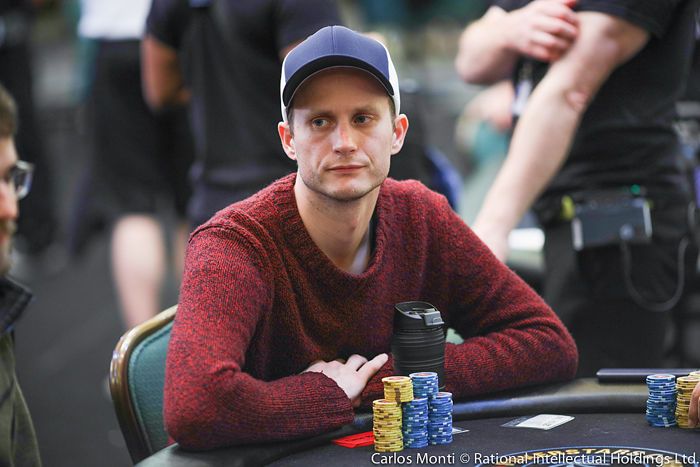
Hand 2 - Turning a Flush Draw
With the blinds at 300/600/600 (button ante, not big blind ante), I had 90,000 and my primary opponent in this hand about 50,000. The under-the-gun player limped and the hijack raised to 1,700. I called out of the small blind with A?3?, the big blind came along, and the UTG limper also called to make it four-way action to the one-heart 10xQx3x flop, which everyone checked.
On the 7? turn, I bet 3,000 with my pair and flush draw and both the big blind and UTG player folded. The hijack raised to 7,400 and I opted to call.
Deadman: "This hand is mostly fine, it's just the turn sizing I think we should go bigger."
"The pot is 7,700 on the turn. I like our turn lead after flop checks through, but I think we should go a bigger size," says Deadman.
"We want to make it tough for our opponents to call. For 3,000, it's easy for them to call QxXx, 10xXx, etc. I'd bet close to pot, like 7,000. I think this size gets a lot more folds which is the best result for us even though we have good equity versus most hands. It's a strange line for the hijack to raise here. He should have only 7x7x for value as his strong hands should bet this flop when it's four-way. However, I would assume our opponent just slow played a set on flop when he should have bet and I think he's given us a good price to call for a flush."
Unfortunately, I missed the flush when an offsuit Jx bricked the river, and I check-folded to a bet of 11,000.
"This hand is mostly fine, it's just the turn sizing I think we should go bigger," Deadman concludes. "I think we rarely get raised on the turn here if we bet big, and if they do [raise] they just have two-pair plus."
For more from Deadman, visit simondeadmanpokercoaching.com.
In this Series
- 1 Hold��em with Holloway, Vol. 1: Making Reads and Trusting Them
- 2 Hold��em with Holloway, Vol. 2: Playing in Poker Charity Events
- 3 Hold��em with Holloway, Vol. 3: Throttle Back Before You End Up Punting
- 4 Hold��em with Holloway, Vol. 4: Punish the Satellite Bubble
- 5 Hold��em with Holloway, Vol. 5: What is Proper Accumulator Strategy?
- 6 Hold��em with Holloway, Vol. 6: A Chip and a Chair Story with ��SirWatts��
- 7 Hold��em with Holloway, Vol. 7: 15 Things About Poker I Wish I��d Known Sooner
- 8 Hold��em with Holloway, Vol. 8: Examining the Largest Overlay in Poker History
- 9 Hold��em with Holloway, Vol. 9: Differences Between Rebuys and Reentries
- 10 Hold��em with Holloway, Vol. 10: Five Must-Read Poker Books of 2014
- 11 Hold��em with Holloway, Vol. 11: When Will You Finally Break Through?
- 12 Hold��em with Holloway, Vol. 12: Dealing with a Target on Your Back
- 13 Hold��em with Holloway, Vol. 13: Knowing When to Call It Quits
- 14 Hold��em with Holloway, Vol. 14: Embarking on a Year-Long Weight Loss Journey
- 15 Hold��em with Holloway, Vol. 15: Navigating Multiple Decision Points in a Poker Hand
- 16 Hold��em with Holloway, Vol. 16: Chris Moorman Tells Me How Badly I Play Poker
- 17 Hold��em with Holloway, Vol. 17: Richard ��nutsinho�� Lyndaker on Getting It in Marginal
- 18 Hold��em with Holloway, Vol. 18: Getting Inside the Head of Poker Pro Brian Rast
- 19 Hold��em with Holloway, Vol. 19: Stupid Calls & Lucky Draws in MSPT WI Championship
- 20 Hold��em with Holloway, Vol. 20: Talking Ante-Only Strategy with Greg ��FossilMan�� Raymer
- 21 Hold��em with Holloway, Vol. 21: Contributing to Jonathan Little��s New Book
- 22 Hold��em with Holloway, Vol. 22: Consequences of Acting Out of Turn & Tossing in Chips
- 23 Hold��em with Holloway, Vol. 23: When It Comes to Chops, Do What��s In Your Best Interest
- 24 Hold��em with Holloway, Vol. 24: Accepting Bad Beats & Lessons in Selling Action
- 25 Hold��em with Holloway, Vol. 25: Heinz�� Ace-High Call Shows Why He's a World Champ
- 26 Hold��em with Holloway, Vol. 26: Is Keeping the Short Stack Alive Collusion?
- 27 Hold��em with Holloway, Vol. 27: Great Laydown or Bad Fold on Poker Night in America?
- 28 Hold��em with Holloway, Vol. 28: Calling Hellmuth with Jack-Deuce Offsuit
- 29 Hold��em with Holloway, Vol. 29: The Philosophy of "No-Chop" Chad
- 30 Hold��em with Holloway, Vol. 30: Preparing to Play the World Series of Poker
- 31 Hold��em with Holloway, Vol. 31: Staying on Your Grind at the World Series of Poker
- 32 Hold��em with Holloway, Vol. 32: The Perilous Decision to Call Off with Ace-Queen
- 33 Hold��em with Holloway, Vol. 33: Using Poker Skills in Reality TV Competitions
- 34 Hold��em with Holloway, Vol. 34: Esfandiari Explains How to Recover from Bad Beats
- 35 Hold��em with Holloway, Vol. 35: Tilly vs. Brunson in Super High Roller Cash Game Hand
- 36 Hold��em with Holloway, Vol 36: Unconventional Play Leads to Good WSOP Main Event Start
- 37 Hold��em with Holloway, Vol. 37: Lessons in Pot-Limit Omaha Hi-Low w/ Evan Jarvis
- 38 Hold��em with Holloway, Vol. 38: Things to Say and Do When You Bust a Poker Tournament
- 39 Hold��em with Holloway, Vol. 39: How Much Did I Have to Raise to Get You to Fold?
- 40 Hold��em with Holloway, Vol. 40: Practicing Patience in My Deep PPC Poker Tour Run
- 41 Hold��em with Holloway, Vol. 41: Analyzing a Questionable SHRPO Main Event Hand
- 42 Hold��em with Holloway, Vol. 42: Analyzing the Play of Neymar Jr. at EPT Barcelona
- 43 Hold��em with Holloway, Vol. 43: The Value of a Reliable Poker Reputation
- 44 Hold��em with Holloway, Vol. 44: John ��KasinoKrime�� Beauprez Rips My PLO Game Apart
- 45 Hold��em with Holloway, Vol. 45: Satellite Dilemmas -- To Call or Not to Call
- 46 Hold��em with Holloway, Vol. 46: Seiver Leverages the River in Super High Roller Bowl
- 47 Hold��em with Holloway, Vol. 47: What Untraditional Moves in Poker Might Mean
- 48 Hold��em with Holloway, Vol. 48: Thinking About the Future with Sam Grizzle
- 49 Hold��em with Holloway, Vol. 49: WCOOP Champ ��Coenaldinho7�� Offers Up His Biggest Hands
- 50 Hold��em with Holloway, Vol. 50: The Peril of Shoving Weak Aces
- 51 Hold��em with Holloway, Vol. 51: The Importance of Not Giving Up in Poker Tournaments
- 52 Hold��em with Holloway, Vol. 52: Does Asking ��Check�� Actually Constitute a Check?
- 53 Hold��em with Holloway, Vol. 53: Thomas Cannuli Impresses Even After Main Event Bustout
- 54 Hold��em with Holloway, Vol. 54: Dealers Aren��t Always Right
- 55 Hold��em with Holloway, Vol. 55: Don��t Get Married to Pocket Aces
- 56 Hold��em with Holloway, Vol. 56: Bazeley��s Survival Instinct Leads to Continued Success
- 57 Hold��em with Holloway, Vol. 57: Playing ��Deuces Wild�� on the European Poker Tour
- 58 Hold��em with Holloway, Vol. 58: The Wildest Hand in European Poker Tour History
- 59 Hold��em with Holloway, Vol. 59: Death, Zombies & Spending Time w/Phil Hellmuth
- 60 Hold��em with Holloway, Vol. 60: How the Unstoppable Fedor Holz Managed to Win Again
- 61 Hold��em with Holloway, Vol. 61: Lessons To Be Learned When You Hit the Big Stage
- 62 Hold��em with Holloway, Vol. 62: Steve O��Dwyer Explains the ��Oreo Cookie Tell��
- 63 Hold��em with Holloway, Vol. 63: What Would Happen to a Chip Stack If a November Niner Died?
- 64 Hold��em with Holloway, Vol. 64: Forgetting One Chip -- Should It Still Be an All-In Bet?
- 65 Hold��em with Holloway, Vol. 65: Todd ��sharkslayerrr�� Breyfogle on Bankroll Management
- 66 Hold��em with Holloway, Vol. 66: Cash Game Pro Daniel Arfin Offers Sound Bankroll Advice
- 67 Hold��em with Holloway, Vol. 67: Honeyman Plays Kings to Keep in Opponent��s Bluff Range
- 68 Hold��em with Holloway, Vol. 68: Why Do I Even Bother Drinking at the Poker Table?
- 69 Hold��em with Holloway, Vol. 69: Is Your Favorite Poker Pro Left- or Right-Handed?
- 70 Hold��em with Holloway, Vol. 70: In Order to Live You Have to Be Willing to Die
- 71 Hold��em with Holloway, Vol. 71: How to Amass a Big Stack Early in a Poker Tournament
- 72 Hold��em with Holloway, Vol. 72: Answering User-Submitted Poker Scenarios
- 73 Hold��em with Holloway, Vol. 73: Saying Goodbye with a Top Five List
- 74 Hold'em with Holloway, Vol. 74: We're Back, Baby!
- 75 Hold'em with Holloway, Vol. 75: Jivkov on Exploiting Capped Ranges
- 76 Hold��em with Holloway, Vol. 76: Matt Bretzfield Gets Tricky With Aces
- 77 Hold'em with Holloway, Vol. 77: Joseph Cheong Gets Crazy with a Pair of Ladies
- 78 Hold'em with Holloway, Vol. 78: Wyoming Poker Action & Wild South Dakota Hand
- 79 Hold'em with Holloway, Vol. 79: Calling Controversy at WinStar
- 80 Hold'em with Holloway, Vol. 80: Going for Value with Matt Hunt
- 81 Hold'em with Holloway, Vol. 81: Bracelet Winner Ryan Leng on Bad Call
- 82 Hold'em with Holloway, Vol. 82: Romeopro33 Recounts XL Eclipse Victory
- 83 Hold'em with Holloway, Vol. 83: Men The Master Doesn't Get Paid
- 84 Hold'em with Holloway, Vol. 84: Harman Hits Back-to-Back Miracle Turns
- 85 Hold'em with Holloway, Vol. 85: Jamie Kerstetter on Dealing with Bounties
- 86 Hold'em with Holloway, Vol. 86: Matt Stout Develops a Limp Dynamic
- 87 Hold'em with Holloway, Vol. 87: Matt Alexander Caught in Between w/ Two Red Aces
- 88 Hold'em with Holloway, Vol. 88: John Beauprez on Why He Folded a Set of Jacks
- 89 Hold'em with Holloway, Vol. 89: Alex Aqel Lets Opponent Hang Himself with Aces
- 90 Hold'em with Holloway, Vol. 90: David Peters Makes Beastly Call Against Will Givens
- 91 Hold'em with Holloway, Vol. 91: Poker Lessons from a Game of Risk
- 92 Hold'em with Holloway, Vol. 92: My Upstuck Diagnosis by the CLC Squad
- 93 Hold'em with Holloway, Vol. 93: Alex Foxen Coolers Nick Petrangelo in SHRB
- 94 Hold'em with Holloway, Vol. 94: My $25,000 PSPC Experience at 2019 PCA
- 95 Hold'em with Holloway, Vol. 95: The Equity of Leveraging Time Extensions
- 96 Hold'em with Holloway, Vol. 96: Dan O'Brien on Developing Healthy Routines
- 97 Hold'em with Holloway, Vol. 97: Big Hands From the WSOP-C Potawatomi
- 98 Hold'em with Holloway, Vol. 98: Simon Deadman Rips Apart My NLH Tourney Play
- 99 Hold'em with Holloway, Vol. 99: Shoving 10-6 Smack Dab Into Pocket Aces
- 100 Hold'em with Holloway, Vol. 100: The Revived Re-Entries Debate

